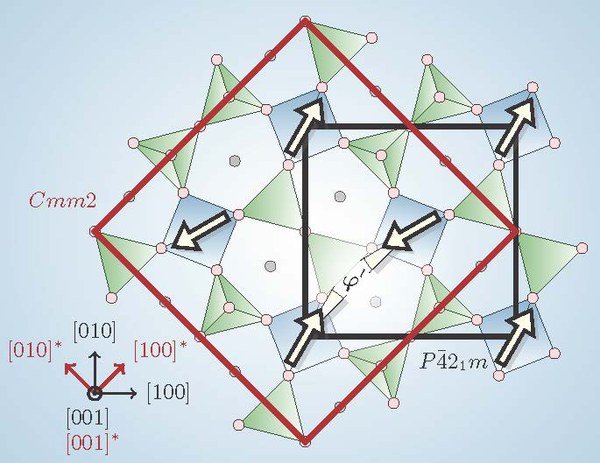Current Scientific Topics from Users at HEiDi and POLI
Germanium-based multiferroic compounds with melilite structure

Magnetoelectric multiferroic compounds where both electric polarization and magnetic order coexist at the same temperature and are coupled to each other are of significant interest in the modern solid-state physics because of their potential applicability for the low-energy information storage media. The elucidation of the mechanisms of magnetoelectric coupling in different materials as well as finding of the new types of magnetoelectric multiferroics remains a challenging task from both theoretical and experimental point of view.
Electric polarization under applied magnetic fields has been reported for different barium based melilite type germanates Ba2XGe207 (X = Mn, Co, Cu) and Co åkermanite silicates A2CoSi207 (A = Ca, Sr).
The peculiar behavior of the electric polarization with magnetic fields (both direction and magnitude dependent), the occurrence of such interesting magneto-optical phenomena like giant directional dichroism of terahertz light in resonance with magnetic excitations (electromagnons), optical magneto-chiral effect, quadrochroism generated by the optical magnetoelectric effect, as well as quantum fluctuations in dielectric parameters at high fields rules out some of the generally accepted models for type II multiferroics, namely spin-current or exchange-striction.

Various new microscopic mechanisms have been proposed to describe strong magnetoelectric coupling in these materials. Most of them are bases on purely theoretic considerations. A precise knowledge of the magnetic order and the magnetic anysotropy at the unit-cell level and their evolution with applied magnetic and electric field would significantly help in the distinguishing between different theoretical models and enhance the understanding of magnetoelectric coupling in these interesting materials.
Also, understanding the role of the specific magnetic atoms and magnetic interactions leading to different magnetic structures within the same crystal symmetry, and their impact on the emerging electric polarization are of fundamental interest.
Team:
Dr. Martin Meven
Publications:
- A. Sazonov, V. Hutanu, M. Meven, G. Roth, R. Georgii, T. Masuda and B. Nafradi, “Crystal structure of magnetoelectric Ba2MnGe2O7 at room and low temperatures by neutron diffraction”, Inorg. Chem. 57, 5089−5095 (2018).
- A. Sazonov, V. Hutanu, M. Meven, G. Roth, H. Murakawa, Y. Tokura, V. K. Guduru, L. C. J. M. Peters, U. Zeitler, L. F. Kiss, D. Szaller, B. Nafradi, and I. Kezsmarki, “Magnetic structure of the magnetoelectric material Ca2CoSi2O7” Phys. Rev. B 95, 174431 (2017).
- A. Sazonov, M. Meven, G. Roth, R. Georgii, I. Ke´zsma´rki, V. Kocsis, Y. Tokunaga, Y. Taguchi, Y. Tokura, & V. Hutanu, “Origin of forbidden reflections in multiferroic Ba2CoGe2O7 by neutron diffraction: symmetry lowering or Renninger effect?” J. Appl. Cryst. 49, 556-560 (2016).
- V. Hutanu, A. P. Sazonov, M. Meven, G. Roth, A. Gukasov, H. Murakawa, Y. Tokura, D. Szaller, S. Bordács, I. Kézsmárki, V. K. Guduru, L. C. J. M. Peters, U. Zeitler, J. Romhányi, and B. Náfrádi, “Evolution of two-dimensional antiferromagnetism with temperature and magnetic field in multiferroic Ba2CoGe2O7”, Phys. Rev. B 89, 064403 (2014).
Phase diagram of Eu magnetic ordering in Eu(Fe1-xCox)2As2 single crystals

This member of the pnictide family shows a broad variety of magnetic and superconducting features. Especially the interplay of the Eu and Fe magnetic sublattices in combination with various Co content require detailed studies with single crystal neutron diffraction. Using the short wavelengths of HEiDi to overcome the strong Eu neutron absorption in these compounds HEiDi was able to contribute significant information to various studies on this family of compounds.
Publications:
Phase diagram of Eu magnetic ordering in Sn-flux-grown Eu(Fe1−xCox)2As2single crystals; W. T. Jin, Y. Xiao, Z. Bukowski, Y. Su, S. Nandi, A. P. Sazonov, M. Meven, O. Zaharko, S. Demirdis, K. Nemkovski, K. Schmalzl, Lan Maria Tran, Z. Guguchia, E. Feng, Z. Fu and Th. Brückel; Phys. Rev. B 94, 184513; DOI: 10.1103/PhysRevB.94.184513
Magnetic structure of EuFe2As2 determined by single crystal neutron diffraction;Y. Xiao, Y. Su, M. Meven, R. Mittal, C.M.N. Kumar, T. Chatterji, S. Price, J. Persson, N. Kumar, S.K. Dhar et al.; Phys. Rev. B, 80:174424; DOI: 10.1103/PhysRevB.80.174424
Studies on technologically relevant compounds for all-solid-state batteries - the garnet-type solid-state electrolyte Li6La3ZrTaO12
Ceramic electrolytes with high ionic conductivities are a prerequisite for the next-generation of all-solid-state lithium batteries as well as a negligible electronic conductivity to avoid self-discharge and/or formation of Li dendrites, being currently one of the key issues hindering the development of long-lasting all-solid-state batteries. The garnet-type Li6La3ZrTaO12 (LLZO) is an ideal model system for detailed studies on effects driven by extrinsic or intrinsic factors such as impurities, chemical inhomogeneities, grain boundaries, morphology and size effects. The high instrumental resolution of HEiDi allowed for comprehensive structural studies on the pure and Ta doped single crystals.

a, b) Crystal structure of Ga-containing Li6.4Ga0.2La3Zr2O12 (space group I43d (No. 220)) as determined by a combined, simultaneous refinement of both data from X-ray diffraction and neutron diffraction. The Li ions are distributed over three different crystallographic sites (12a (Li1), 12b (Li2), 48e (Li3)) in the acentric space group. Ga3 + ions share sites with Li+located at the Li1 site, being the Wyckoff position 12a. The Li+ ions form a 3D network enabling them to quickly diffuse through the crystal structure [3].
Team:
Dr. Martin Meven
Publications:
[1] Single-crystal neutron and X-ray diffraction study of garnet-type solid-state electrolyte Li6La3ZrTaO12: an in situ temperature-dependence investigation (2.5 ≤ T ≤ 873 K); G. J. Redhammer, M. Meven, S. Ganschow, G. Tippelt and D. Rettenwander; Acta Cryst. B 77, 123-130 (2021); DOI: 10.1107/S2052520620016145
[2] Wet-Environment-Induced Structural Alterations in Single- and Polycrystalline LLZTO Solid Electrolytes Studied by Diffraction Techniques; Günther J. Redhammer, Pavan Badami, Martin Meven, Steffen Ganschow, Stefan Berendts, Gerold Tippelt, and Daniel Rettenwander; ACS Appl. Mater. Interfaces, 350–359 (2021); DOI: 10.1021/acsami.0c16016
[3] The Electronic Conductivity of Single Crystalline Ga ‐ Stabilized Cubic Li7La3Zr2O12: A Technologically Relevant Parameter for All ‐ Solid ‐ State Batteries; Martin Philipp, Bernhard Gadermaier, Patrick Posch, Ilie Hanzu, Steffen Ganschow, Martin Meven, Daniel Rettenwander, Günther J. Redhammer, H. Martin R. Wilkening; Adv. Mater. Interfaces 7, 200450 (2020); DOI: 10.1002/admi.202000450
